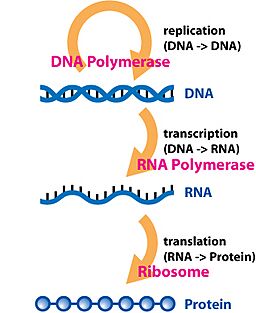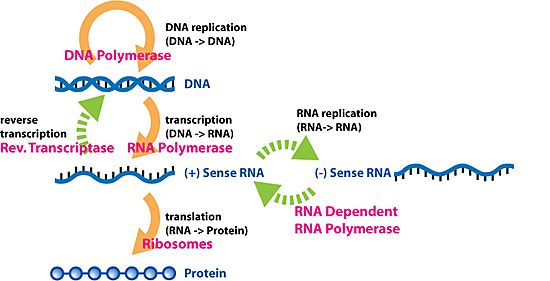Central dogma of molecular biology facts for kids
The central dogma of molecular biology is a big name for a simple idea that explains how living things work. It describes how the instructions in our genes are used to build and run our bodies. You might have heard it as "DNA makes RNA, and RNA makes protein." This is a good summary, but the real idea is a bit more detailed.
The idea was first explained by the scientist Francis Crick in 1958. He said that genetic information flows from nucleic acids (like DNA and RNA) to proteins. But once the information is in a protein, it can't flow back to the nucleic acids. Think of it like a one-way street for information.
Contents
The Main Steps of the Central Dogma
Think of your DNA as a giant cookbook that contains all the recipes for making every part of you. The central dogma explains how these recipes are read and used.
Step 1: DNA Replication (Copying the Cookbook)
Before a cell divides to make a new cell, it needs to copy its entire DNA cookbook. This process is called DNA replication. It ensures that every new cell gets a complete set of instructions.
A group of special proteins works like a copying machine, unzipping the DNA and making a new matching copy of each side. This way, you get two identical DNA cookbooks from the original one.
Step 2: Transcription (Writing a Recipe Card)
You wouldn't take the entire giant cookbook to the kitchen just to bake a cake. Instead, you'd copy the cake recipe onto a small card. The cell does something similar in a process called transcription.
When a cell needs to make a specific protein, it copies the instructions for that one gene from the DNA onto a new molecule called messenger RNA (mRNA). The mRNA is like a recipe card that can leave the cell's nucleus (the library where the DNA is kept) and travel to the cell's kitchen.
Step 3: Translation (Baking the Cake)
The mRNA recipe card travels to a part of the cell called a ribosome, which is like the cell's protein-making factory or kitchen. Here, the process of translation happens.
The ribosome reads the mRNA recipe three letters at a time. These three-letter "words" are called codons. Each codon tells the ribosome which ingredient to add next.
The ingredients for proteins are called amino acids. Another type of RNA, called transfer RNA (tRNA), acts like a delivery truck, bringing the correct amino acid to the ribosome based on the codon it reads. The ribosome then links the amino acids together in a long chain, which folds up to become a working protein.
Are There Exceptions to the Rules?
Science is full of surprises, and the central dogma has a few interesting exceptions. These are special cases where the flow of information is a bit different.
Reverse Transcription: Going from RNA to DNA
Usually, information flows from DNA to RNA. But some viruses, called retroviruses, can go backward! They use a special enzyme to turn their RNA code back into DNA.
This allows the virus to insert its own genetic instructions into the host cell's DNA. It's like a hacker adding a new, unwanted recipe to the master cookbook.
RNA Replication: Copying RNA Directly
Some other viruses don't bother with DNA at all. Their genetic material is RNA, and they have special enzymes that can make new copies of RNA directly from the original RNA. This is like photocopying a recipe card instead of going back to the cookbook.
A Strange Case: Prions
Prions are a fascinating and unusual example of how information can be passed on. Prions are not viruses or bacteria; they are a type of protein that has folded into the wrong shape.
The strange thing about a prion is that if it touches a normal, correctly folded protein of the same type, it can cause the normal protein to misfold and become a prion too. This starts a chain reaction, where one misfolded protein creates many more.
This is a rare case where information (the wrong shape) is passed from protein to protein. It doesn't change the cell's DNA, but it shows another way that biological information can be transferred.
Why Is It Called a "Dogma"?
The word "dogma" usually means a belief that cannot be questioned, like in a religion. So why did Francis Crick use such a strong word for a scientific idea?
Years later, Crick explained that it was a bit of a mistake! He said he didn't fully understand what the word "dogma" meant to most people. He thought it just meant a big, important idea or a "grand hypothesis."
He wanted to show how important and central this idea was to biology. He later joked that he could have just called it the "Central Hypothesis," but "Central Dogma" was the name that stuck.
See also
 In Spanish: Dogma central de la biología molecular para niños
In Spanish: Dogma central de la biología molecular para niños




